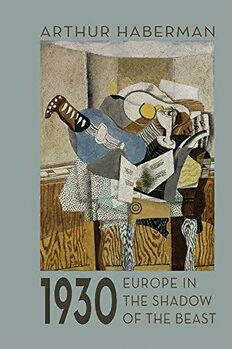
1930: Europe in the Shadow of the Beast PDF
Preview 1930: Europe in the Shadow of the Beast
Haberman: 1930 08/14/18 i 1930 Haberman: 1930 08/14/18 ii This page intentionally left blank Haberman: 1930 08/14/18 iii 1930 EUROPE IN THE SHADOW OF THE BEAST ARTHUR HABERMAN Haberman: 1930 08/14/18 iv Wilfrid Laurier University Press acknowledges the support of the Canada Council for the Arts for our publishing program. We acknowledge the financial support of the Gov- ernment of Canada through the Canada Book Fund for our publishing activities. This work was supported by the Research Support Fund. an Ontario government agency un organisme du gouvernement de l’Ontario Library and Archives Canada Cataloguing in Publication Haberman, Arthur, [date], author 1930 : Europe in the shadow of the beast / Arthur Haberman. Includes bibliographical references and index. Issued in print and electronic formats. ISBN 978-1-77112-361-7 (softcover).—ISBN 978-1-77112-363-1 (EPUB).— ISBN 978-1-77112-362-4 (PDF) 1. Intellectuals—Europe—History—20th century. 2. Europe—Intellectual life— 20th century. I. Title. II. Title: Nineteen thirty. CB205.H33 2018 940.5’2 C2018-900842-3 C2018-900843-1 Front cover image: Georges Braque, The Blue Mandolin (1930). Cover design and interior design by Angela Booth Malleau, designbooth.ca. © 2018 Wilfrid Laurier University Press Waterloo, Ontario, Canada www.wlupress.wlu.ca This book is printed on FSC® certified paper and is certified Ecologo. It contains post- consumer fibre, is processed chlorine free, and is manufactured using biogas energy. Printed in Canada Every reasonable effort has been made to acquire permission for copyright material used in this text, and to acknowledge all such indebtedness accurately. Any errors and omissions called to the publisher’s attention will be corrected in future printings. No part of this publication may be reproduced, stored in a retrieval system, or transmit- ted, in any form or by any means, without the prior written consent of the publisher or a licence from the Canadian Copyright Licensing Agency (Access Copyright). For an Access Copyright licence, visit http://www.accesscopyright.ca or call toll free to 1-800- 893-5777. Haberman: 1930 08/14/18 v To the memory of my teachers: Joan Kelly Gadol (1928–1982) and A. William Salomone (1915–1989) Haberman: 1930 08/14/18 vi And what rough beast, its hour come round at last, Slouches towards Bethlehem to be born? —Yeats, “The Second Coming” Haberman: 1930 08/14/18 vii CONTENTS Introduction 1 Prologue: Europeans, 1930 5 1 Thomas Mann: The Uncanny and Its Power 17 2 Virginia Woolf: Transcending 33 3 José Ortega y Gasset: Rethinking the West 49 4 Bertolt Brecht and Kurt Weill: Rethinking Theatre, Remaking Opera 67 5 L’âme noir: The Black Soul in the City of Light 87 6 L.H.O.O.Q.: Painting in 1930 107 7 Aldous Huxley: Fearing the Future 129 8 Sigmund Freud: The Fragility of Civilization 143 9 Yesterday and Today 163 Epilogue: Europeans Today 213 Acknowledgements 221 Notes 223 Bibliographical Notes 231 Additional Reading 239 Index 241 vii Haberman: 1930 08/14/18 ii This page intentionally left blank Haberman: 1930 08/14/18 1 INTRODUCTION THE YEAR 1930 was hardly a happy one for Europe and the West. The effects of the disaster of the Great War were still seen and felt. Economically, the Wall Street crash in October 1929 began a time when the viability of liberal capitalism was seriously questioned. In Italy there was a new authoritarian- ism claiming to be the wave of the future. Communism was a hope, a fear, and, mostly, an unknown. A number of European writers and artists dealt with the time as a crisis of culture and civilization. Some were friends, others were hardly known to the rest. However, 1930 saw a coming together on the part of the major intellectuals of Europe about European values and stability, and the future of the continent. What makes 1930 such a watershed is that rarely have so many important minds worked independently on issues so closely related. All argued that something was seriously amiss and asked that people become aware of the dilemma. Writers such as Thomas Mann, Virginia Woolf, José Ortega y Gasset, Sigmund Freud, and Bertolt Brecht acted as public intellectuals, asking hard questions about the survival of a Western tradition that went at least as far back as the Enlightenment and sometimes to the Renaissance and its classical revival. The central issues were: • The viability of a secular Europe with Enlightenment values Most wondered whether the direction of modernity had taken a dark turn with the event of the Great War and the rise of a strident and violent ethnic nationalism. Could the best of European culture survive a turn inward to destruction and fear? • Coming to terms with a new, darker view of human nature Now, in place of a view of human nature as either Cartesian (Cogito, ergo sum), as one that claimed we are distinguished by our capacity to reason, or as one that says we create with our labour (Homo faber), 1
